The Nuclear Power Plant Sarcophagus, Chernobyl Exclusion Zone
There’s something deeply unsettling about this panoramic view of the Chernobyl nuclear power plant that hits you right in the gut. What you’re looking at used to be a bustling industrial complex where thousands of people worked every day, going about their routines, completely unaware that everything was about to change forever. Now it sits there like a massive concrete tomb, silent and abandoned, wrapped in that protective sarcophagus that serves as a constant reminder of the disaster that happened here.
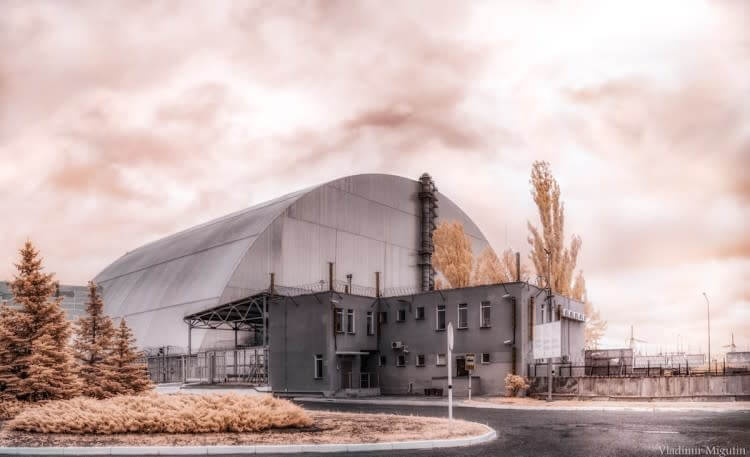
The infrared photography creates this almost otherworldly atmosphere that feels perfectly suited to the subject matter. That vivid pink sky stretching endlessly above the grey, imposing structure of the power plant creates such a stark contrast that it’s almost beautiful in a terrifying way. The colors don’t look like anything you’d see in the natural world, which somehow makes the whole scene feel even more removed from normal life, like you’re looking at the remains of a different planet entirely.
You can’t help but feel the weight of history pressing down when you look at this image. This isn’t just an abandoned building – it’s a monument to one of humanity’s greatest technological disasters, a place where time essentially stopped on April 26, 1986. The desolation is so complete, so final, that it leaves you with this hollow feeling in your chest, knowing that this landscape will remain largely untouched for generations to come.
The Monumental Trail With The Evacuated Villages’ Names On Either Side
Walking down this trail feels like stepping into a memorial that stretches as far as the eye can see. The photographer has captured something incredibly powerful here – row after row of signs bearing the names of villages that were completely evacuated after the disaster. You start reading them and quickly realize just how massive the scale of displacement really was. It’s not just one or two communities we’re talking about – it’s dozens upon dozens of places where people had lived for generations, all suddenly emptied overnight.
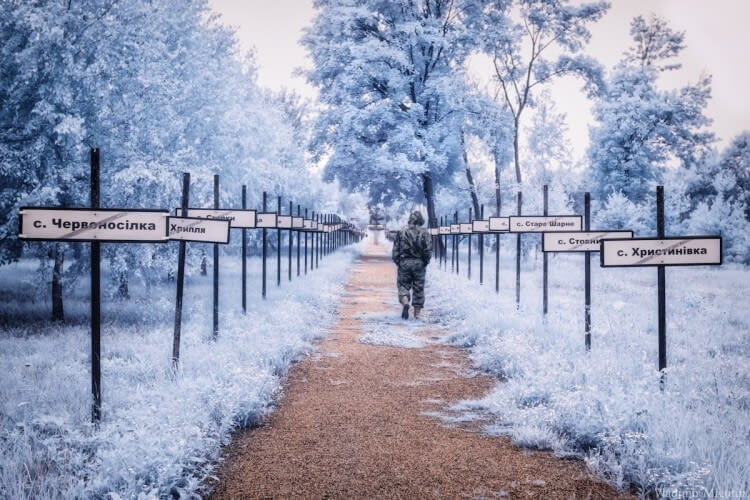
What’s particularly striking is how these village name signs look almost exactly like cemetery markers standing in neat rows along the path. Whether this resemblance was intentional or just a tragic coincidence, the effect is absolutely haunting. Each sign represents an entire community that was essentially killed off – not the people necessarily, but the life, the culture, the daily routines that made these places home. The neat, orderly arrangement makes it feel like you’re walking through a graveyard for lost towns.
The infrared photography adds another layer of eeriness to the whole scene, making the signs glow against the alien-looking landscape. It’s impossible to walk this trail without thinking about all the families who had to pack up their entire lives in a matter of hours, leaving behind everything they couldn’t carry. These aren’t just names on signs – they’re the final markers of communities that will never exist again, preserved here like headstones in this strange, pink-tinged world.
This Beautiful Fox Often Approaches Groups In The Exclusion Zone, Asking For Food
Meet Simon, probably the most charming resident you’ll encounter in the Chernobyl Exclusion Zone. This little guy has zero fear of humans and will actually walk right up to visitor groups, almost like he’s learned that these strange two-legged creatures sometimes come bearing snacks. There’s something both heartwarming and heartbreaking about watching this fox approach people with such trust, especially knowing that most of the world has written off this entire area as uninhabitable. Simon clearly didn’t get that memo.
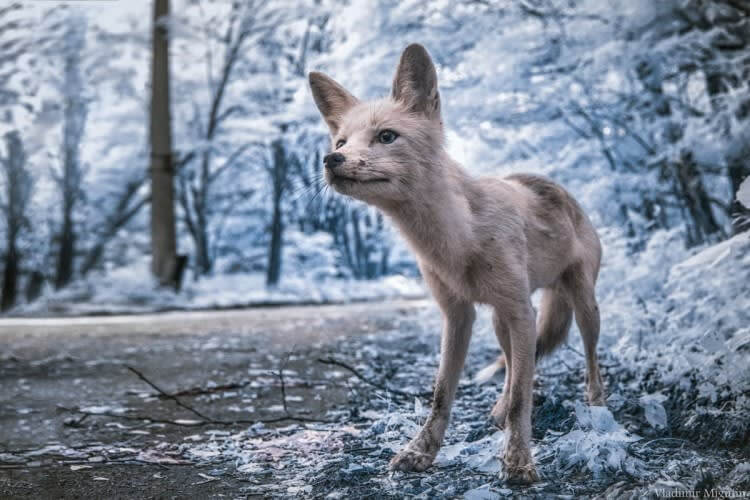
You can tell just by looking at him that life in the exclusion zone isn’t exactly easy living. His frame is noticeably lean, and there’s something in his eyes that speaks to the constant search for food that defines his daily existence. The way he stares at visitors isn’t just curiosity – it’s hope, maybe even a bit of desperation disguised as friendliness. While the absence of humans has allowed wildlife to return to the area in surprising numbers, it doesn’t mean these animals are thriving in the way they would in an uncontaminated environment.
What’s fascinating is how Simon represents this weird contradiction that exists throughout Chernobyl. On one hand, nature has reclaimed so much of the territory that was abandoned after the disaster, with animals roaming freely through former villages and towns. On the other hand, the reality of survival in a radioactive landscape means these creatures face challenges that their ancestors never had to deal with. Simon’s willingness to approach humans might just be his way of adapting to a world that’s neither fully wild nor fully civilized anymore.
The Ghost Town Of Pripyat, Ukraine
Pripyat is one of those places that gets under your skin in a way that’s hard to shake off. This photograph captures exactly why – there’s something deeply unsettling about seeing nature slowly but relentlessly reclaiming what humans built. Those residential tower blocks used to be filled with families going about their daily lives, kids playing in the hallways, neighbors chatting on balconies. Now they’re being consumed by trees and vines, like the forest is trying to erase any evidence that people ever lived here at all.
The infrared photography makes the scene even more haunting by creating this stark contrast between the cold, grey concrete of the abandoned buildings and the almost glowing vegetation that’s taking over. It’s beautiful in the most disturbing way possible – nature doesn’t care about human tragedy, it just does what it always does and keeps growing. Those trees pushing through windows and wrapping around structures look almost aggressive, like they’re in a hurry to bury this chapter of history.
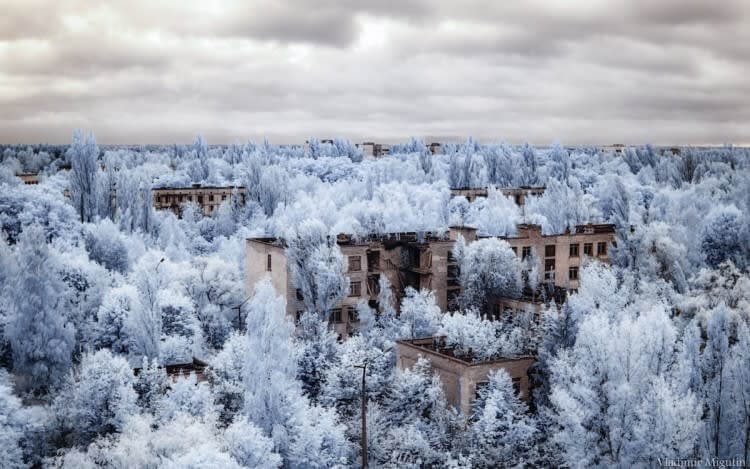
What really hits you is realizing that this transformation is happening everywhere throughout Pripyat. It’s not just one building or one street – it’s an entire city slowly disappearing under a green blanket. The people who lived here had to leave everything behind in a matter of hours, and now the forest is methodically erasing their former home piece by piece. In a few more decades, you have to wonder if there will be anything left to show that a thriving community of 50,000 people once called this place home.
The Azure Swimming Pool In Pripyat
There’s something particularly heartbreaking about abandoned swimming pools, and this shot of the Azure Swimming Pool in Pripyat really drives that feeling home. You can almost hear the echoes of what this place used to be – kids cannon-balling off that diving platform, parents cheering from the spectator gallery, the constant splash and laughter that would have filled this space on any given day. Swimming pools are supposed to be places of joy and community, which makes seeing one sitting empty and forgotten feel like a punch to the gut.
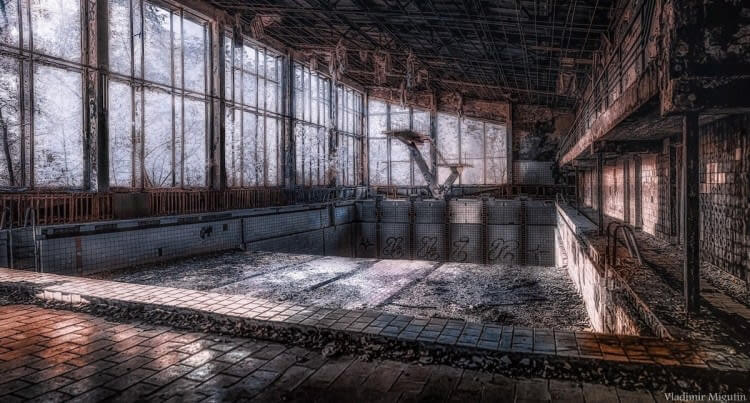
The infrared photography transforms what would already be a haunting scene into something almost otherworldly. The way the light plays across the empty pool basin and reflects off the still-intact diving platform creates this eerie glow that makes the whole facility look frozen in time. You can see the spectator seating area still there, probably designed to hold hundreds of people who would gather to watch diving competitions or just enjoy a day at the pool. Now it’s just empty concrete benches overlooking nothing but silence and decay.
What gets to you most is imagining how normal this place must have felt to the people who used it regularly. The Azure Swimming Pool wasn’t just a recreational facility – it was probably where kids learned to swim, where teenagers hung out on summer afternoons, where families spent weekends together. It was woven into the fabric of daily life in Pripyat, and now it sits there as this monument to all the ordinary moments that were suddenly cut short. The silence that’s fallen over this place isn’t just the absence of sound – it’s the absence of life itself.
Butterflies And Flowers In The Forest, Chernobyl Exclusion Zone
Sometimes the most unexpected beauty emerges from the darkest places, and this photograph is perfect proof of that. Here in the heart of what most people consider a nuclear wasteland, life is absolutely flourishing in ways that seem almost defiant. These delicate butterflies dancing around wildflowers create such a stark contrast to everything we think we know about Chernobyl – instead of death and desolation, you’re looking at this explosion of color and movement that feels almost magical. It’s like nature decided to throw a party in the one place on earth where you’d least expect it.

The infrared photography really brings out the vibrancy of this scene in a way that makes it feel almost dreamlike. Those flowers seem to glow with an inner light, and the butterflies look like they’re floating through some kind of fairy tale forest rather than a place that’s been branded uninhabitable for decades. It’s incredible how quickly nature bounced back once humans stepped out of the picture – no lawn mowers, no pesticides, no construction crews, just pure wilderness doing what it does best.
What really blows your mind is realizing that this kind of scene is probably happening all over the exclusion zone, hidden away from the world’s attention. While we’ve been focused on the abandoned buildings and the human tragedy, an entire ecosystem has been quietly rebuilding itself in the shadows. These butterflies don’t know they’re living in a “nuclear wasteland” – they just know there are flowers to visit and no humans around to disturb them. Maybe that’s the real lesson here: life finds a way to thrive even in the most impossible circumstances.
Abandoned Farm In Chernobyl Exclusion Zone
There’s something gut-wrenching about abandoned farms that hits different than other kinds of ruins. This isn’t just a building that’s been left behind – it’s someone’s entire way of life, their livelihood, their connection to the land, all just sitting there rotting away. You can almost picture the family that once called this place home, tending to their crops, caring for their animals, probably never imagining that one day they’d have to walk away from everything they’d built and never come back. The skeletal remains of what was once a working farm tell a story of lives interrupted in the most brutal way possible.
That faded “Men At Work” sign on the side of the cabin is what really gets you. It’s such a small detail, but it speaks volumes about the sudden nature of the evacuation. Someone put that sign up expecting work to continue, repairs to be made, life to go on as usual. Instead, it’s become this accidental memorial to all the human activity that just stopped overnight. The irony is almost too much to bear – no men have worked here for decades, and none will for decades to come.
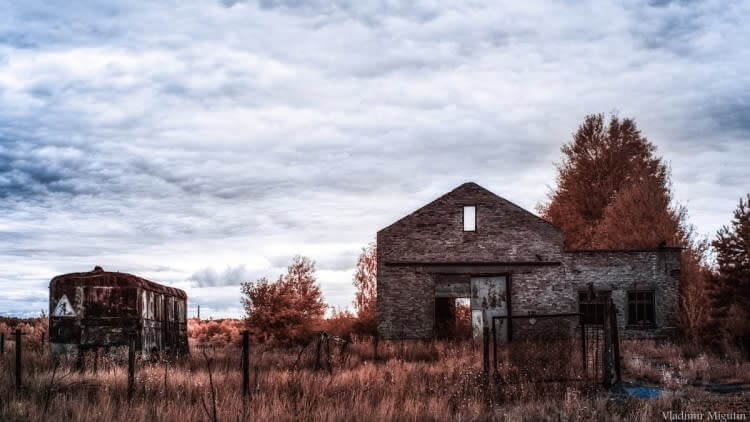
Even with the beautiful sky and the trees gradually taking over, there’s no escaping the profound emptiness that radiates from this scene. Nature might be reclaiming the structures, but it can’t fill the void left by the people who once made this place alive with purpose and meaning. The infrared photography somehow makes it even more haunting, turning what should be a peaceful rural scene into something that feels frozen in time, caught between the life that was and the silence that remains.
The Rotting Grand Piano In The Concert Hall Of The Town Of Pripyat
This image hits you like a physical blow to the chest. Here’s this grand piano, once the centerpiece of countless evenings filled with music and laughter, now standing alone in a crumbling concert hall where the only sound is the creaking of decaying wood. You can almost hear the ghost of melodies that once filled this space – classical pieces, maybe some popular songs, the kind of performances that brought the entire community together on weekend nights. Now it’s just silence, broken only by the slow collapse of everything around it.
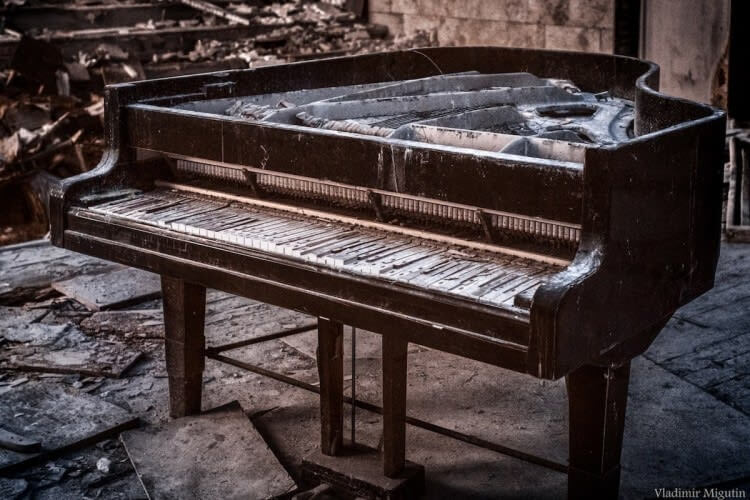
What’s absolutely heartbreaking is how the piano itself seems to be refusing to give up even as everything else falls apart. The floorboards have rotted away and collapsed, chunks of the ceiling have probably come down, but that instrument is still standing there like it’s waiting for someone to come back and play it one more time. There’s something almost defiant about the way it holds its ground, as if it’s the last guardian of all the cultural life that once thrived in Pripyat. The keys are probably warped beyond repair, the strings long since snapped, but the basic structure remains intact.
You can’t help but think about all the moments this piano witnessed – children’s recitals, romantic serenades, community celebrations, maybe even someone nervously playing their first public performance. It was probably the pride of the town, the kind of instrument that made people feel like they were part of something sophisticated and cultured. Now it’s become this haunting symbol of how quickly civilization can crumble, yet also how some things endure even when everything else falls away. That piano is still there, still proud, still waiting for music that will never come.
